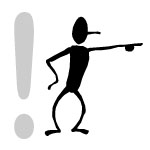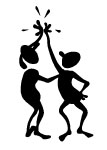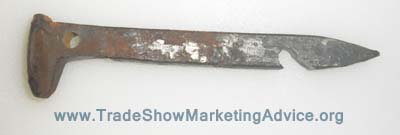|
 Does
trade show marketing work? Are trade shows still relevant in the new age of
online marketing, websites, Twitter, Facebook, Google, Bing, iPhones, iPads, and
social media? Or are trade shows and trade show marketing just last century's
marketing dinosaurs? Is it still worthwhile to exhibit at a trade show or
convention, especially in today's economy? Does
trade show marketing work? Are trade shows still relevant in the new age of
online marketing, websites, Twitter, Facebook, Google, Bing, iPhones, iPads, and
social media? Or are trade shows and trade show marketing just last century's
marketing dinosaurs? Is it still worthwhile to exhibit at a trade show or
convention, especially in today's economy?
The simple answer is a resounding, YES, trade show marketing
DOES work, which is why every year there are thousands of trade shows held
through the US and the world, with millions of attendees. And there are tens of
thousands of trade show exhibitors who are successful, introducing new products
and selling existing products, meeting new customers, and establishing new
business relationships. Trade shows are still the most cost-effective "face-to-face" marketing
method available today and are effective for any range of companies whether in the realm of
digital advertising, legal work for even plumbing & drain cleaning or sewerage services. Trade show marketing allows an exhibitor to meet with hundreds of motivated
potential customers. But trade show success is not a foregone conclusion
nor is it guaranteed, and unfortunately, far too many exhibitors waste much
of the potential value of trade show marketing because they don't following a few simple
rules...
PLAN, QUALIFY, FOLLOW-UP
3 simple "Golden Rules" to make your next
trade show a success!
Repeat after me... PLAN. QUALIFY. FOLLOW-UP. Now say those
three words again. These three concepts are so simple, but it seems to me, are also so
often overlooked by many exhibitors. Too often I have seen exhibitors that
instead (1) try to do everything at the last minute, (2) want to talk to and
sell to every passerby, and (3) then go back to work and wait for the phone to
start ringing and the orders to start flowing in... May I instead suggest
the following approach:
 1. PLAN [before your show] 1. PLAN [before your show]
One of my favorite quotes is "Failing to plan is planning to fail."
I couldn't agree more. Plan for your trade show, and start early.
a. Determine your Purpose: What is the purpose of
exhibiting at this show? Are you introducing a new product? Trying
to get new customers? Do you just have to be seen there (if so, make it
worth it).
b. Set Goals (especially financial goals): I want to meet "x" new prospects a
day. I want to get "$x" of new orders a day. I want to contact "x"
current customer and arrange to show them our new widget at the show. Evaluate
your ROI (Return On Investment or profit delta) and make sure you'll make money
by exhibiting (or at least your accounting nerd says there is a strong
potential to profit from the show) and that is doesn't appear that you'll
spend more money by exhibiting than you'll make!
c. Make a Checklist: what do you have to do?
Secure a booth space? Order carpet, power, etc? Do you need a
portable booth? Do you need graphics? Do you need the graphics
designed? Do you need new literature? Do you need to contact current
customers and let them know you'll be at the show?
d. Assign Responsibility: Who has to do what?
This is really easy for a one-person exhibit, but if you have a group of people
or a team that is responsible to for your trade show exhibiting, then all the
responsibilities must be clearly assigned or delegated to specific individuals
to make sure nothing is overlooked or forgotten, and to avoid the infamous, "But
I though [fill in the blank with anybody but me] was taking care of that..."
e. Create a Timeline and Set Deadlines:
f. Pre-show Promotion: let people know you'll be there
(postcards, emails, phone calls).
g. Create an incentive for them to visit your booth:
Consider some kind of drawing or handing out
trade show giveaways. Tell people to
bring your pre-show mailer by the booth and they can redeem it for a "super hip
xyz widget" (i.e. trade show giveaway) or they can drop it in a box (after
answer all the question on the questionnaire of course) and they'll then qualify
to win a new iPod (for example).
h. Keep in mind the big picture. You're competing with
hundreds of exhibitors among all the other trade show booths. You've got to insure that your trade show display
will stand out from all the other trade
show displays, which means you'll need a stand-out, breakthrough
trade show booth design. Multiple studies
by various trade show industry experts have repeatedly confirmed that a typical
trade show booth or exhibit only has a few seconds to catch the eye of an
attendee as they walk by, and if your graphics aren't great, you'll just get
passed by. Because of this, it's usually a good idea to hire a expert
professional designer, and you want to get one with specific expertise in trade
show graphics. Just because a designer has designed websites or brochures
doesn't mean that he or she knows what's important for designing effective
graphics for a trade show environment. It's important to keep your trade show
message focused and short.
i. Plan, plan, plan...
j. see step "i" above ("I" means "YOU") :)
 2. QUALIFY [at your show] 2. QUALIFY [at your show]
It always surprised me how many trade show booth staffers tried to sell
to everyone. I suppose they thought they could sell refrigerators to
Eskimos too.
Do be sure to greet everyone passing by, but if they talk to
you, QUALIFY them. Ask if they are in the market for your product or
service. Ask if they have a problem (that you have a solution for, of
course). Ask if they are using any of your competitors. Ask if the
prospect is a decision-maker or influencer. Ask these questions, but then
listen. Give them a chance to talk. Determine what the likelihood of
they or their company ever buying from you is.
If they are not a qualified prospect, thank them, and move
on. If they are, continue your discussion. Get their contact
information, and get some kind of personal information as well and make a note
of it (this will help with your follow-up later). If you think you can get
a sale, by all means go for it. Don't put off until tomorrow what you can
accomplish today.
I think of qualifying trade show prospects as a simple
mathematical formula. If you have 4 good hours of prospecting a day (240
minutes), would you rather spend 5 minutes each with 48 people when 80% of them
would never buy from you (so the 9 good prospects only get 5 minutes of your time
just like the others), or would you rather spend 2 minutes each qualifying the
48, and then have 16 minutes each for your 9 real prospects. I'd rather
have 18 minutes total for each of the 9 real prospects, not just the 5 minutes
that the refrigerator salesman has.
There's a lot more to do at the show [see
what to do & what not to do at your booth],
but qualifying prospects is to often overlooked or misunderstood. So
remember... qualify, qualify, qualify.
 3. FOLLOW-UP [after the show] 3. FOLLOW-UP [after the show]
You're back from your trade show, you're tired, and you have a pile
of mail and a folder full of emails to go through. You've got two meetings
to go to, and your boss wants to go over a new project with you. You've
just worked a Saturday, and you think you deserve some comp time. Your
buddies are over at the coffee maker talking about the game. You've got
too much to do. You gave all your prospects your business card and
brochure, so they'll call you when they're ready to order. You've done
your job.
Stop. Your trade show marketing efforts aren't
finished. Assume that your business card and brochure are
in a plastic bag with 50 other companies on the floor in your prospect's office.
He's in the same boat as you. He'll get to the plastic bag when he gets
time, which turns out to be never, and three months later the entire contents go
into the office recycling bin.
I found that I could double or triple my new customers from a
trade show by doing one thing... follow-up. Call all of your prospects
within 3 days of getting back to work. I've found the best time to call is in
the morning when people are still fresh.. Hopefully you wrote a personal note
on the back of each prospect's business card so that you can mention it and show
that you remember him. Don't stop with one call. Call back in two
weeks, and then in a month. You aren't cold-calling because you already
know your prospect. Follow-up is more work, but with all the work you
already invested in preparing for and going to the show, it's a waste to not
finish the job. So remember... follow-up, follow-up, follow-up! Follow
these three simples steps, PLAN, QUALIFY, AND FOLLOW UP, and be a trade show
success!

featured articles:
the best marketing
secret I ever learned!

what promotional products
really work?

what is a trade show?
what is your trade show strategy?
seven rules for trade show success
trade show giveaway ideas
trade show booth ideas
trade show display ideas
promotional product ideas
more trade show marketing articles
trade show resources
|
unrelated humor | about us / contact us

home of the
soon-to-be-somewhat-famous shark-mouth beer bottle opener
"They can because they think they can." -
Virgil
Providing help, tips, secrets, suggestions, ideas, expertise, DIY know-how,
street-smarts...
and just plain simple old-fashioned trade show
marketing advice since 2004!
about us / contact us
| privacy policy
site credits
The "Screen Bean" characters shown on this sight are copyrighted by the A Bit
Better Corporation.
Screen Beans Art © A Bit Better Corporation
Institute
for Trade Show
Marketing Excellence | ITSME
http://www.TradeShowMarketingAdvice.org
copyright 2004-2015, all rights reserved - USA
|